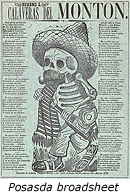|
|
|
 |
Newspapers first appeared in Europe in the mid-17th century.
They evolved gradually from a similar type of publication called
a broadsheet—a single sheet of paper that responded to
unusual events. Although newspapers today and those in the past
resemble one another in many ways, newspapers and their content
have changed dramatically over time. Newspapers in different
societies are often quite different from those you may be familiar
with. Thus, it is important to read newspapers from different
times (and places) carefully. |
 For
example, this is the front page of the Times of London, one
of the most complete and accurate newspapers in the world in the mid-1800s,
on the morning after the Battle of Gettysburg, a major historical
event. Someone reading this paper in the 21st century might be surprised
to find nothing about the battle, but the timely and broad coverage
we now expect was not always available. For
example, this is the front page of the Times of London, one
of the most complete and accurate newspapers in the world in the mid-1800s,
on the morning after the Battle of Gettysburg, a major historical
event. Someone reading this paper in the 21st century might be surprised
to find nothing about the battle, but the timely and broad coverage
we now expect was not always available.
Technological innovation made the modern newspaper
possible. Before the late 19th century, paper was often made from
textile fibers like cotton and linen, frequently taken from recycled
rags. Only after the invention of paper made from wood pulp did low-cost,
low-quality paper become readily available. The rise of the paper
industry made paper cheap, which meant that newspapers could be printed
for reasonable prices. Industrialization and new global markets, especially
in raw materials, helped to increase production leading to inexpensive,
mass-produced paper.
 |
Changes in print technology influenced
newspaper production as well. Print began with individual metal
letters placed by hand in special grids. The letters were inked
and then paper was pressed on one sheet at a time. Technological
innovations steadily decreased the amount of effort and increased
the speed at which words could be printed onto paper.
In the 19th and 20th centuries, it also became
easier and cheaper to move information across long distances,
which had a huge impact on the newspaper business. Railroads
and steamships made long-distance travel easier and faster beginning
in the early 19th century, so reporters could travel to interesting
events. With the invention of the telegraph in the mid-19th
century, traveling correspondents could report back to newspapers
regularly and rapidly. Images, too, could be sent over the wires,
and as photographic technology improved in the second half of
the 19th century, news photos became a reality.
|
As words and pictures moved ever more quickly around
the world in the 20th century, newspapers began to rely on wire services
like Reuters and Agence-France Presse. These services had
reporters and photographers based all over the world, and they enabled
newspapers that could not hire foreign correspondents to cover distant
events quickly and in detail.
The rise of the wire services also caused increasing
similarities in the content of newspapers from different places. Beginning
with World War II, reports of nonlocal events were similar in newspapers
from the Philippines to Nova Scotia. Newspaper readers sometimes recognize
this phenomenon immediately from the bylines—the line at the
beginning of the story bearing the author’s name—of newspaper
stories. If a story is attributed to UPI (United Press International)
or a similar organization, rather than an individual reporter, it
comes from a wire service and is often reprinted in hundreds of different
newspapers. Syndication through wire services also led to the advent
of features—comic strips, advice columns, editorial cartoons,
opinion columns, and even weather reports and movie reviews—shared
among many newspapers.
As the price of paper and printing dropped, and
as access to information from faraway places became faster and easier,
newspapers grew larger and appeared more frequently. They changed
from occasional broadsheets to regularly issued almanacs to daily
papers to papers with several editions per day. In the past decade,
the advent of the Internet as a mass communications medium also has
helped speed up the news cycle: some stories now appear on newspaper
websites in multiple editions, written and rewritten over the course
of the day. This can create confusion when archiving or citing newspaper
stories for those researching recent history.
 
|



